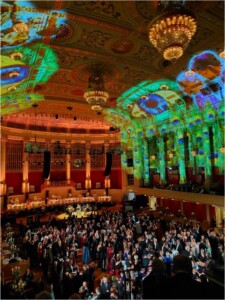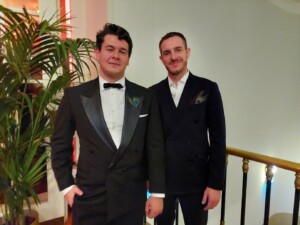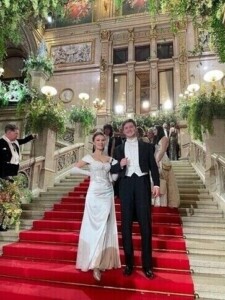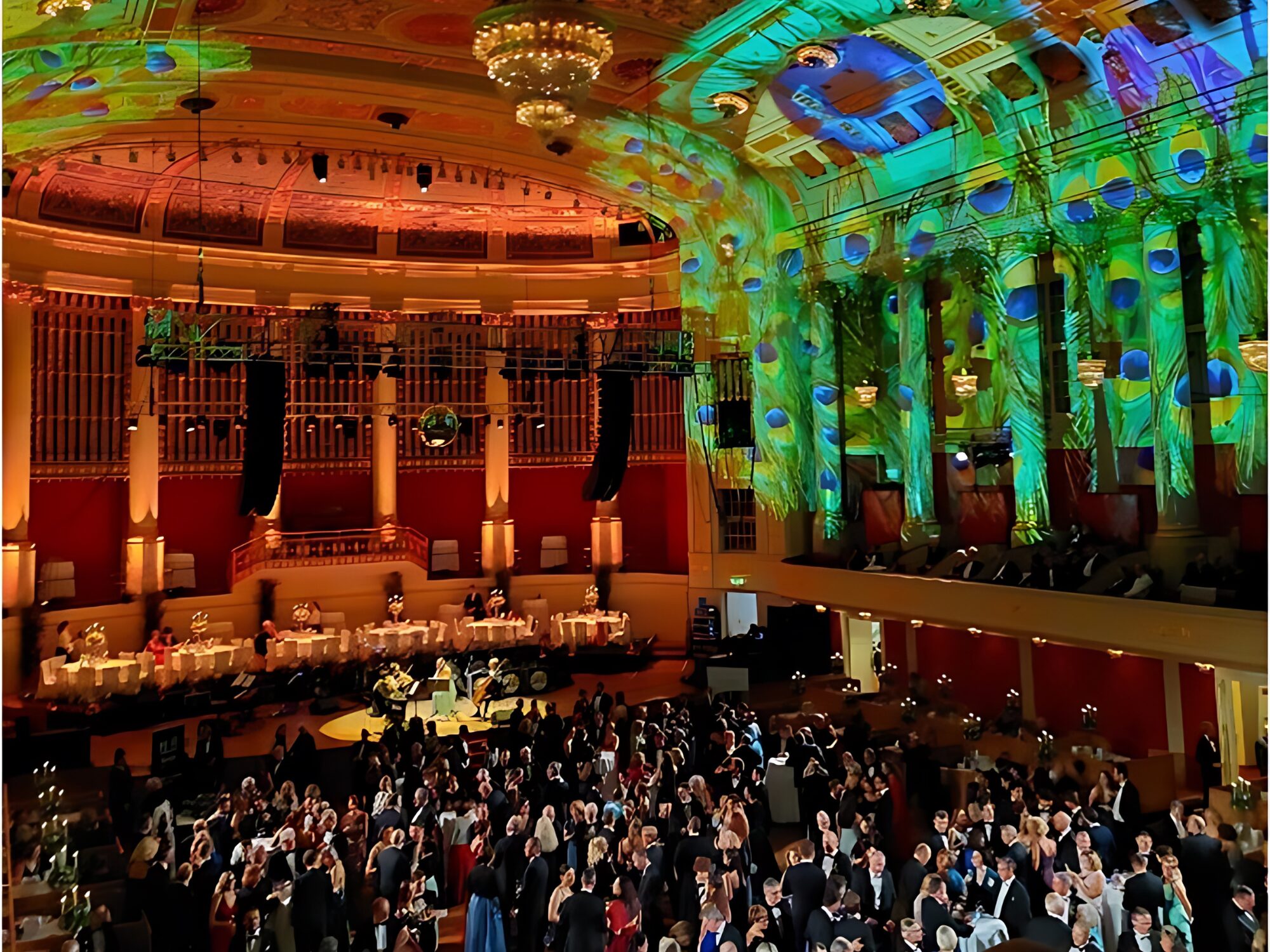It’s fancy, it’s party, it’s gloomy – a Viennese ball has it all. Ball culture in Austria’s capital is unique to the city and an elegant way to celebrate or just to immerse yourself in the local cultural heritage. Why is Ball Season so special here and how has it developed the way it is today? Which elements at these glamorous soirees have been preserved and what changed? Our author Decho knows.
What is a Viennese Ball?

The festive hall in the townhall during the Vienna Ball of Sciences (photo: private)
Many have their “ball” at the end of high school, or the so-called “prom ball” at some point in their lives. On such events ladies dress in elegant long dresses, whereas men usually wear some form of a tuxedo. There is dancing, but rather in freestyle. A Viennese Ball takes everything to another level. It is a huge event that revolves around a given idea or a charity cause (for example, the Medical Doctors’ Ball, where one of the charities is to raise awareness about ME/CFS). And there are those which have a political significance (such as the Opera Ball where political figures like the Federal President Alexander van der Bellen or the current Chancellor of Austria Karl Nehammer attend). Viennese Balls are a vivid example of politics and culture being interwoven – reason enough for protesters to regularly use the events and demonstrate while political party leaders are dancing in the halls.
But you should not be deceived. Balls are beloved by all ages and you don’t need a special invitation in order to attend. You can just buy a ticket, get your best dress or your most elegant suit and waltz along on the dance floor during the whole night, no matter your age!
My Very First Viennese Ball
My first Viennese ball was the “The Vienna Ball of Sciences”. It took place at the Rathaus (Town Hall) in winter 2023 and was organised by the Wolfgang Pauli Institute which hosts numerous events for researchers and scientists from different disciplines.
At the event, I witnessed elegant people from all walks of life and many different nationalities. There were ladies in amazing green dresses and men in stylish tailcoats, but I also saw a whole group of ladies wearing kimono, the Japanese national dress.
As the ball’s name suggests, the main theme here is science and during the night there were many initiatives promoting their inventions – for example, there was a stand where you could try vegan meat made out of peas. The main audience was us, the students. I was surprised by the affordable ticket prices while the setting was just as lavish. There was a little bit for everyone – a standard dance hall to dance waltz, quickstep or foxtrot, a latin hall for dances such as salsa, cha-cha or bachata, a tango hall and a disco hall.
Alles Walzer!

The main hall of the Vienna concert house at the night of the dance (photo: private)
This year, I attended another ball called “The Viennese Night of Dance” (“Wiener Nacht des Tanzes”) and it went over all of my expectations. The Dance School where I regularly go dancing myself organises the ball – Tanzschule Kraml. Live orchestra accompanied the huge hall of the Concert Hall with a dark ambient where you could see projected peacock feathers which were the symbol of the event. Dress code was therefore as “Black tie peacock”. This meant a tuxedo with a peacock feather on the lapel for the men. And many ladies had them stitched in their hair, which can take you back to 1920s cabaret style.
A Lavish Foreplay

“This ball is a high demonstration of good taste”, remarked my friend Daniel (right) (photo: private)
The opening was just as grand, the debutants just as beautiful. The moment I heard the iconic phrase “Alles Walzer!” (“The Waltz can begin!”), something changed in the atmosphere and everyone – youngsters, elderly, students – rushed to the dancefloor to the opening waltz, including me, of course. In a nutshell, the opening ceremony of a ball is a lavish foreplay to the real party.
A Fairy Tale for a Night
After that, everything went so fast through my head. As any modern ball, the event also offered space for different types of dances like salsa, tango milonga, swing, disco. So in the first moment, I was in the big hall waltzing, in the second dancing salsa, in the third rocking on a jive, in the fourth enjoying sparkling wine with my friends. There were so many young people at the ball. Practically no one stayed in their own bubble. You invite someone on a dance, and you dance, discuss and laugh. In the end, you come back home and reminisce the fairy tale you just experienced.
The Climax at Midnight
At midnight came the highlight of the evening – the quadrille. The quadrille is an old French dance. Everyone is in pairs and you all build two parallel lines (which can be impressively long and tight). Your pair dances with the pair in front of you (so you dance in a group of 4 people). There is always a “narrator” that announces every step, but it is not necessary that everyone would do them properly. This evening was no exception! In a crowd of more than 500 people it is highly likely that you lose your partner somewhere. Either you find them again, or someone else comes to your line, but the show must go on!
The video will demonstrate this pretty accurately.
Traditional Ball Culture Meets Young People
As previously mentioned, many young people do love the ball, because they are filled with flair, emotions and unforgettable experiences. There are events whose specific target are the students. Along with the Vienna Ball of Sciences, another popular student ball is the WU Ball.It is organised by the Student Association of the Vienna University of Economics and Business – and I see numerous stories on Instagram from it by most of my friends in Vienna.
More Than Just an Ordinary Dance
Moreover, the concept of the ball is being newly rewritten. The Tanzschule Kraml organises every year the so-called summer night ball (Sommernachtsball), where the dresscode is all white. And yet again, you see different elegant stylings with only one main colour.. Fortunately, me and my friends who I met during my Erasmus semester in Frankfurt – Thea and Polina – had the opportunity to attend this year’s Sommernachtsball.
From a First-Time Perspective

Thea and her brother as debutants of the Vienna Opera Ball.
(photo: private)
Thea, on the other hand, revealed exclusive insights. She also attended the big Opera Ball as a debutant: “Of course we also have balls in Germany, but it is not that common for young people to be interested in it. So I appreciate how this culture is maintained and preserved in Vienna from generation to generation. As a debutante, I had to obey a strict dress code, exact guidelines on hairstyle, makeup and even shoes. I even had to buy a second dress, because my previous one wasn’t the required nuance of white. Everything was dealt with to the detail, but I will never forget this one grand moment as me and my brother stepped into the Vienna Opera house alongside with the other pairs and all eyes were on us.”
The context is that debutants are allowed to open the Opera Ball only once and dresscode seems to be quite conservative for both men and ladies.
Two Balls, One Idea
Thea continues: “During the summer night ball, there were different shows during the night. And because it was summer, you could actually dance outside. So the overall atmosphere was easy-going and liberal. But again I saw how the event brought young and elderly together. Even at the Opera Ball, there were not only dancefloors for ball dancing. There are even more: for disco, so the students could go waltzing on the one and party hard on the other. When the sun finally came out, we had breakfast at Sacher. Here you see the connection between past and present that Ball culture brings ”
An Overall Remark

“A ball is a place where people and their love for dancing come together”: Me (centre), Polina (left) and Thea (right)
(photo: private).
And what do I think about ball culture in Vienna? There are many ways to party or celebrate, but the ball is the fanciest and most elegant one. It is not really important if you can dance or not. You are welcome to join, drink champagne and meet interesting people from all walks of life – just have an amazing time with your family and friends. You can do all this while enjoying one of Vienna’s most enduring traditions, spending quality time and connecting to the city’s vibrant history.
Check out more blogposts in our Featured Archive.





